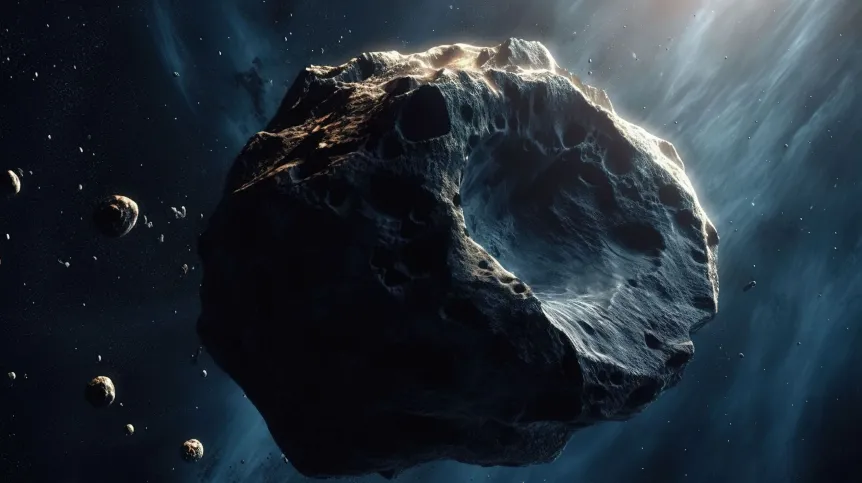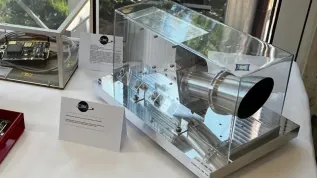
The risk of an asteroid impact that would threaten our civilization is minor, but it cannot be ruled out. Scientists are working on improving the methods for detecting and predicting the trajectories of such objects. Possible defence methods are also being developed, Dr. Tomasz Barciński and Dr. Małgorzata Królikowska-Sołtan from the Space Research Centre of the Polish Academy of Sciences told PAP.
Dr. Tomasz Barciński is the head of the Space Mechatronics and Robotics Laboratory at the Space Research Centre of the Polish Academy of Sciences. He specializes in control theory and mechatronics. He leads teams that work on the most important space missions with Polish participation, including the construction of the European X-ray space telescope ATHENA and the Comet Interceptor probe designed to intercept a comet from outside the Solar System. He also works on the 'space garbage truck' project in the ESA ClearSpace program, and on the Polish observation satellite Eagle Eye.
Dr. Małgorzata Królikowska-Sołtan, a professor at the Space Research Centre of the Polish Academy of Sciences, works in the Solar System Dynamics and Planetology Group of the Space Research Centre PAS and is a former head of the Group. Her interests include the dynamics of small Solar System objects, including the influence of non-gravitational effects on their orbits.
Polish Press Agency: An asteroid several dozen meters long recently passed our planet at a distance less than the distance between the Earth and the Moon. From time to time there are reports of a similar objects approaching. What is the probability that within, say, a hundred years, an asteroid will hit the Earth and threaten our civilization or destroy a large part of a continent?
Dr. Małgorzata Królikowska-Sołtan: In short: very small, also because the larger the object, the less likely it is to hit. Every year, several tons of fine dust enter the Earth's atmosphere and 'burn' in it, and one or a few lumps several meters in size hit the Earth somewhere. However, because the surface of our planet is mostly covered with water, we often do not notice it.
PAP: The sky has been watched for a long time, also for potentially dangerous objects. Do many such objects remain unknown?
M.K.S.: The sky has been systematically monitored for about 20 years, today we are doing it more and more intensively and we are able to see increasingly fainter, i.e. smaller objects further and further away (earlier). There are many projects dedicated strictly to the search for objects that threaten the Earth. Several large near-Earth asteroids (above 1 km) are discovered every year. It is estimated that well over 90 parent of objects of this type have already been discovered. At the same time, every year we still discover several hundred near-Earth asteroids larger than 140 m. This fact alone allows to conclude that many such objects still remain unknown.
PAP: How difficult is it to estimate whether a given object is dangerous to the Earth?
M.K.S.: An expert knows how to do it, and today NASA routinely deals with it, updating the state of knowledge about such objects. But the big problem is that it's not enough to count once to sleep peacefully. The orbit of each asteroid is constantly affected by planetary perturbations - that is, it changes (all orbits that are given anywhere are temporary orbits - for a specific date, the so-called epoch; they are professionally called oscillating orbits). We know how to numerically calculate the movement of such asteroids in our Solar System, taking into account the gravitational interaction not only from planets, but also from the most massive asteroids. However, the longer the period of predicting the movement of a given asteroid, the greater the uncertainty of its trajectory.
PAP: Can you explain it with an example?
M.K.S.: Imagine that today we know the orbit of an asteroid very well. However, if our uncertainty of the minimum distance at which it will pass the Earth is at the level of several dozen meters, this difference may determine whether, for example, in 20 years this asteroid will collide with the Earth or not. Calculations sometimes show a very narrow range of distances from Earth (at the moment of the asteroid's closest approach to Earth - PAP), which may result in a whole series of collisions with Earth in the future. We then talk about the 'keyhole' phenomenon. It is not enough to calculate the orbits of each object once and conclude that it is or it is not an Earth-threatening asteroid. All known NEOs (Near-Earth Objects) need to be under constant surveillance, especially those we know will pass within a safe but short distance from Earth in the future.
PAP: The risk of hitting the Earth is small, but not zero. Could we defend ourselves against a dangerous asteroid with current technology?
Dr. Tomasz Barciński: That depends, among other things, on its trajectory, i.e. how it moves. It can fly faster or slower. At a higher speed, you would have to deflect its flight more, and therefore use more force. Gravitational interactions are also important, they can facilitate the task or make it more difficult. So changing the path of the asteroid can be relatively easy and only a small correction is enough, or the exact opposite situation may happen.
PAP: Can we assume that in simpler scenarios we would manage?
T.B.: We would have a chance. This was demonstrated during the DART mission that slightly changed the path of one of the objects in a binary asteroid system. That mission managed to slightly change the orbit of Dimorphos - the moon of the asteroid Didymos. The probe sent from Earth simply hit Dimorphos and transferred its energy, its momentum to it. The change was significant enough to be seen with ground-based telescopes. If a similar object were heading towards the Earth and the conditions were favourable - we would have a chance to defend ourselves against it.
PAP: How exactly did the probe sent in the DART mission work?
T.B.: In order to change the path of a celestial body, a force must be applied to it. In the DART mission, a spacecraft collided with a space object and gave up its momentum, much like a ball hitting another ball. The spacecraft crashed completely on the asteroid, which means that it practically transferred all its momentum to it. This collision is quite a complex process, in which the probe is destroyed, a fragment of the surface of the asteroid is destroyed and its fragments are thrown backwards in the form of a plume. Still, the sum of the momentums of the asteroid and the space probe before and after the collision certainly hardly changes.
PAP: How many asteroids can react to this type of action? What if one of them is covered with a thick layer of dust, or it is a rather loose collection of many small rocks?
T.B.: It may be counterintuitive, but this method should still work. It doesn't matter how soft the asteroid is. It is important that the vehicle crashes on it completely. Then the momentum is transferred to the struck object. In the case of an object in the form of many loose particles, this method can also work, provided that the striking vehicle does not fly through the object, but stops in it, and the collision does not break the object into pieces.
PAP: Are there other methods?
T.B.: Towing. One or more spacecrafts land on the surface and push the asteroid with rocket propulsion. There is an interesting possibility here. In some cases, fuel could be produced from local regolith. We can also throw the regolith itself in the opposite direction, using, for example, easily available solar energy. Firstly, it will cause the asteroid to move by recoil, and secondly, it will reduce its mass. It sounds a bit like science fiction, but so was the DART mission that just ended successfully.
PAP: You mentioned solar energy. Doesn't its action directly deflect certain bodies?
T.B.: There are ideas to direct focused sunlight or a laser at the asteroid, and thus evaporate material from its surface. Also in this case, a recoil force will be created that will push the asteroid in the opposite direction.
PAP: And more drastic methods?
T.B.: You can land on an asteroid, drill a hole or several in it and place charges, for example, nuclear ones. Then there is an explosion and the asteroid disintegrates.
PAP: Is it possible to predict the effects of such a procedure? After all, many fragments can form that may create an even greater threat.
T.B.: That is true, which is why this approach requires many simulations in which various scenarios are tested. They take into account, for example, a whole range of initial conditions and verify the possible effects of an explosion.
PAP: Can the structure of an asteroid surprise scientists? If they enter the wrong data into the simulation, the result will also be incorrect.
T.B.: Unfortunately, that is also true. That is why, in this case, sometimes we talk about two-stage missions. In this type of project, a probe would fly first, orbit the asteroid and examine it thoroughly, and even look under its surface with appropriate sensors or an impactor. The question is, how much time we would have at our disposal.
PAP: Which methods are researched most intensively?
T.B.: I can name two. There is research into soft landings on light objects. Demonstration missions of this kind have already been conducted, such as the Hayabusa landing on the asteroid Itokawa. The second category is hitting an asteroid, as was the case with the recent DART mission.
I should also mention that the development of space mining is gaining speed, with commercial companies and various institutes investing. It is not even about access to raw materials for use on Earth, but rather using them in space. This includes water, from which rocket fuel can be obtained. Such projects can also help.
PAP: It would seem that theoretically in a few decades we will be quite safe, even if a space object threatened the Earth.
T.B.: Methods such as the impactor used in the DART mission require refinement, others still have to be developed. Fortunately, we live in a very favourable system. We are protected by the huge Jupiter, the outer planet, the powerful gravity of which acts as a vacuum cleaner and attracts a variety of space rocks. Only thanks to it we were able to develop as a human species. (PAP)
PAP - Science in Poland, Marek Matacz
mat/ zan/ kap/
tr. RL













